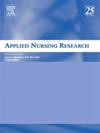Nurse-led implementation of evidence-based bundles to reduce CAUTIs in an academic acute care hospital: A four-year longitudinal quasi-experimental study
IF 2.2
4区 医学
Q1 NURSING
引用次数: 0
Abstract
Aim
This study aimed to evaluate the effectiveness of evidence-based catheter bundles, guided by the Plan-Do-Check-Act model, in reducing catheter-associated urinary tract infections (CAUTIs) and catheter usage at a 643-bed academic hospital.
Background
Despite previous efforts, our facility's CAUTI rates remained high, leading to increased morbidity, extended hospital stays, and higher costs. A four-year project was initiated to implement targeted interventions.
Method
This quasi-experimental study used a four-year strategy, including catheter insertion and maintenance bundles, a nurse-driven removal protocol, and extensive education. We compared pre- and post-intervention data on Standardized Infection Ratios (SIRs) and Standardized Utilization Ratios (SURs) with a goal of greater than 10 % reduction in both metrics; catheter reinsertion rates monitored as a secondary endpoint.
Results
Among 2448 catheterized patients, CAUTI cases declined from 66 to 60. The SIR decreased from 0.93 to 0.58 post-intervention, a 38 % reduction in CAUTI risk (p = .007). Catheter SURs fell from 0.75 to 0.67, an 11 % reduction in utilization risk (p < .001). Reinsertion rates decreased by approximately 6 %.
Conclusions
Nurse-led, evidence-based prevention bundles successfully reduced both CAUTIs and catheter use beyond the 10 % target. These findings underscore the critical role of nursing in driving practice change and improving patient safety.
护士主导的以证据为基础的捆绑实施,以减少学术急症医院的CAUTIs:一项为期四年的纵向准实验研究
目的本研究旨在评估以计划-执行-检查-行动模式为指导的循证导尿管束在减少有643个床位的学术医院导尿管相关尿路感染(CAUTIs)和导尿管使用方面的有效性。背景:尽管以前做过努力,我们医院的CAUTI率仍然很高,导致发病率增加、住院时间延长和费用增加。为执行有针对性的干预措施,启动了一个为期四年的项目。方法这项准实验研究采用为期四年的策略,包括导管插入和维护包、护士驱动的拔除方案和广泛的教育。我们比较了干预前和干预后的标准化感染率(SIRs)和标准化利用率(SURs)数据,目标是两项指标均降低10%以上;导管重新插入率监测作为次要终点。结果2448例留置导管患者中,CAUTI病例由66例下降至60例。干预后,SIR从0.93降至0.58,CAUTI风险降低38% (p = .007)。导管SURs从0.75降至0.67,使用风险降低11% (p < .001)。再插入率下降了大约6%。结论以护士为主导的循证预防包成功地将CAUTIs和导管使用率降低了10%以上。这些发现强调了护理在推动实践变革和提高患者安全方面的关键作用。
本文章由计算机程序翻译,如有差异,请以英文原文为准。
求助全文
约1分钟内获得全文
求助全文
来源期刊

Applied Nursing Research
医学-护理
CiteScore
4.50
自引率
0.00%
发文量
65
审稿时长
70 days
期刊介绍:
Applied Nursing Research presents original, peer-reviewed research findings clearly and directly for clinical applications in all nursing specialties. Regular features include "Ask the Experts," research briefs, clinical methods, book reviews, news and announcements, and an editorial section. Applied Nursing Research covers such areas as pain management, patient education, discharge planning, nursing diagnosis, job stress in nursing, nursing influence on length of hospital stay, and nurse/physician collaboration.
 求助内容:
求助内容: 应助结果提醒方式:
应助结果提醒方式:


